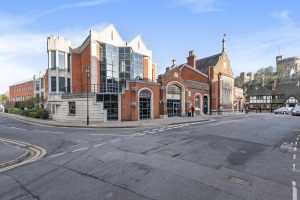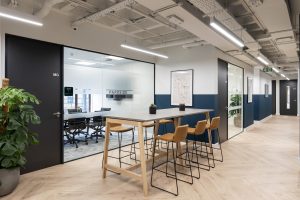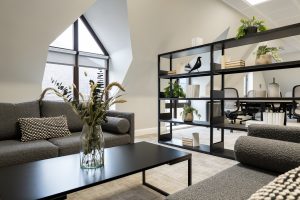Important features of office design

More and more companies are requiring their employees go to the office during the working week – reversing the direction of travel towards remote working that much of the world experienced during the pandemic and its subsequent years.
Even Zoom, the tech company that became synonymous with home working during various global lockdowns, has asked remote employees who live within 50 miles of the office to return to a hybrid approach.
The following is primarily adopted from an RICS Article entitled “The most important features of office design” which in short, can be summarised as – a flight to quality.

Riverside House Windsor – fully renewed and refurbished see www.riversidehousewindsor.com
64% of CEOs surveyed by KPMG think workers will return to the office full-time by 2026. A widespread return to the office has major implications for a commercial real estate sector that has been looking at other ways to generate revenue from large offices that are currently rarely full. The issue with transferring into alternative use (typically residentially aligned) is the balance of remaining office supply – what happens if there’s only one biscuit left in the tin, or simply not enough biscuits left to go around.

Saxon House Windsor – iconic office workspace see more at www.saxonhousewindsor.co.uk
The crunch point has to be, where employees are to spend more time commuting, the office has to meet their needs i.e be worth the commute. Those needs, or the minimum viable office, is the subject of new research by Leesman, the office environment experts who have produced a report called The Workplace Reset based on nearly 158,000 responses from 1,315 workplaces around the world and covers the most important factors for employees when they are working in an office.
The eight most important workplace activities
If employers know which activities their staff spend most time doing, and which they value most highly, this can help them understand the functional side of designing an attractive “commute to” workplace.
The research data shows that a place for individual, desk-based work is the most commonly required element of an office. This is the bedrock of the workplace, as shown by it being important to 92% of respondents, states the report. Quiet, solo, concentrated work is crucial to a positive sense of personal productivity.
“In the evolving landscape of the modern workplace, the needs and expectations of employees have undergone a noticeable shift, particularly with the rise of hybrid working models,” says Catherine Lai MRICS, an ESG consultant and founder of Feeling Amazing Again.
While some aspects of what people seek in their office environment remain consistent with what they desired a decade ago, there are notable changes. The need for a quiet, focused workspace has become even more critical as remote work has shown the productivity benefits of a tranquil environment. And with team members splitting their time between the office and home, readily available meeting rooms equipped with the necessary technology for hybrid collaboration has become a priority.”
Indoor environmental quality
The quality of the office environment has a huge impact on a person’s ability to do their best work. A couple of degrees too hot or too cold can upset a lot of people’s concentration, as can too much noise or bad lighting. These are all elements a person can tailor to their own needs when at home or tolerate more acceptably in their own environment – although quickly a distraction if they are not optimal at work.
The most important feature affecting indoor environmental quality (IEQ) is temperature control, cited by 72% of respondents, followed by noise levels (68%) and natural light (66%).
Pandemic and post-pandemic data has consistently shown the average home is better at supporting the average employee in doing their work than the average office – so the average office has to be better in order to compete with for example acoustic privacy and add to the benefit of the office as a place of collaboration and connection – not as easily achieved at the home environment.
What matters most to older employees
When the responses to the five IEQ elements are divided into age groups, sensitivity to the quality of the indoor environment tends to increase with age. This is especially true of noise levels, office lighting and air quality, which was significantly more important to the over-55s than to the under-35s.
Data shows employees may be more sensitive to ‘noise levels’, ‘office lighting’, and ‘air quality’, while the importance of ‘natural light’ and ‘temperature control’ are more consistently important across all age groups. Perhaps with age and experience also comes higher expectations although there are biological factors at work too – getting older.
Workplace features and furniture
Unsurprisingly, the most important features for anyone working in an office are a desk and chair. They’re there to support so many of the high-importance activities like individual work, planned meetings, or taking a break. Getting these wrong can have big consequences.
Toilets also rank highly as an important workplace feature, a fact that will not be a revelation to anyone that has worked in an office with inadequate or too few or not highly enough specified.
One office feature being more commonly introduced is greenery, or biophilia. Incorporating elements of nature, such as plants, greenery, and natural materials, which can have a calming and stress-reducing effect. Biophilic design fosters a connection with nature, improving overall well-being and creativity.
So into the reality of the above the most successful recent office lettings in our local / regional market have been those which tick most of the above boxes – The Studio Admiral House Windsor has been carefully crafted for great air temperature control, lighting, common facilities and biophilia and ready for Day1 occupation, let on completion of works to D-Flo


Similarly designed space is being taken at 119 Arthur Road Windsor and The Soap Factory West Drayton, with a mix of open plan and cool fully glazed meeting areas has also recently let. Another case in point is the highly presented mix of office sizes at Parkside Windsor, carefully crafted to achieve the relevant “tick boxes” too.


Parkside Windsor – fully fitted for “Day 1” occupancy.
As experts in the office sector Christopher Thomas are currently marketing 45 offices in the west of London home counties region, we are also advising corporate clients through the resizing and reshaping of their office environment, which often involves a full and progressive relocation process. We are always more than delighted to assist our existing clients as well as to meet new.
Christopher Thomas AssocRICS and RICS Registered Expert Witness Surveyor


